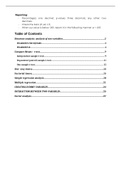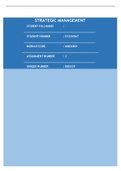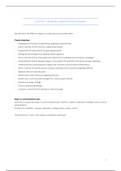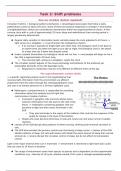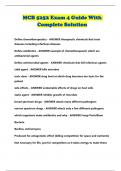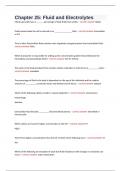Laura Heine – Organisational Psychology: Performance at Work
Problem 4. To train or not to train
What are different learning/training methods? Which one is the best?
ü Kolb, Boyatzis, Mainemelis (2001) – Experiential learning theory: Previous research and new directions
ü Landy, & Conte (2007) – Training and Development
ü Woods, & West (2010) – Learning, Training, development
Training, learning + performance
- Although training can’t change/enhance all individual difference characteristics, it can
be used in combi with selection + other human resource systems to assemble a strong
workforce.
- Training: systematic acquisition of skills/concepts/attitudes that result in improved
performance in another environment.
- Learning: foundation for training programs; relatively permanent change in behaviour
+ human capabilities produced by experience + practice.
o Cognitive outcomes: declarative knowledge, or knowledge of rules, facts +
principles.
o Skill-based outcomes: development of motor + technical skills (= similar to
procedural knowledge).
o Affective outcomes: attitudes/beliefs that predispose a person to behave in
certain way.
- Performance: actions/behaviours relevant to organisation’s goals; measured in terms
of everyone’s proficiency.
- Are all distinct concepts:
o Training is experience expected to lead to learning. How much is learned in
training, however, is influenced by many factors.
o Learning is expected to increase performance on job. Performance usually
directly observed, but learning can’t à assume learning when performance is
observed.
o Learning doesn’t always result in higher performance, but increased likelihood
if attention to training design, principles of learning + work environment.
à Training increases probability of learning; learning increases probability of better
performance.
- Types of training programs: new employee orientation, team training, sexual
harassment awareness + development of cross-cultural, management + leadership
skills. Basis is training model by Goldstein & Ford:
1
, Laura Heine – Organisational Psychology: Performance at Work
Training needs analyses
- 3-step process of organisational, task + person analysis; required to develop a
systematic understanding of where training is needed, what needs to be taught or
trained + who will be trained.
o Organisational analysis: examines company-wide goals + problems to
determine where training is needed. Takes into account manage, peer +
technological support for transfer of training, but also organisational climate.
Can help to ensure that training follows wider human resources strategy,
which needs to follow the overall business strategy. Several organisational
characteristics can affect how much impact training has back on the job: e.g.,
supervisor + peer support à motivate employees + increase likelihood
transfer KSAOs1 to job.
o Task analysis: examines tasks performed + KSAOs required to determine what
employees must do to perform successfully à helpful in determining training
needs.
§ Developing task statements
§ Determining homogeneous task clusters
§ Identifying KSAOs required for job
§ Assessment of competencies: sets of behaviours, usually learned by
experience, that are instrumental in accomplishment of desired
organisational results/outcomes à constantly trying to identify core
competencies required for all jobs; identified by task analysis.
o Person analysis: examines knowledge, skills + current performance to
determine who needs training via performance evaluation system or 360-
degree feedback system, but also data on accidents + job performance, written
tests for current job knowledge. Increasingly being used
- Important to identify training program’s objectives because…
o They represent info for both trainer + trainee about what’s to be learned.
o Help to motivate trainees by providing clear goals for them.
o Are necessary to evaluate training program properly.
- Training needs determined + used to develop training objectives à understanding
how learning works.
1
Knowledge, skills, abilities, and other characteristics
2
, Laura Heine – Organisational Psychology: Performance at Work
Learning process in training
Trainee characteristics:
- Trainee readiness: whether employees have personal characteristics necessary to
acquire knowledge from training program + apply it to the job. Incl.:
o General mental ability (g): predictive of performance in training (.56 predictive
validity). Performance in training related to performance on job. Good to know
g before training to make groups of people with similar levels.
o Goal orientation:
§ Performance orientation: individuals concerned about what doing well
in training + being evaluated positively. Perceive abilities as somewhat
fixed, usually not open to encouragement of errors. Focus on
performance, often at expense of learning. Sensitive to feedback à
reduced efforts + goals in challenging situations.
§ Mastery orientation: individuals concerned with increasing their
competence for task at hand; viewing errors as part of learning
process. More actively engaged in training task, more prepared to
acquire new skills in training + more effective transfer.
à Goals should be set around learning + experimenting with new ways of
performing trained tasks, competition with other trainees should be de-
emphasised + trainees should be actively encouraged to make errors +
experiment with new knowledge/skills during training.
o Experience level: inexperienced + low ability = generally benefitting from
longer and more structured training; experienced + high ability = better
shorter, less structured training. Also prior negative experiences + failures can
heighten motivation to learn.
§ Trainee motivation: extent to which trainees are interested in attending
training, learning from training + transferring skills + knowledge to job.
§ Expectancy framework: approach in which employees’ expectations
about relationship how much effort they expend + how well they
perform are important to their motivation + learning à should develop
environment that facilitates training motivation, which can be
enhanced by using principles from several learning + motivation
theories.
Learning + motivational theories:
1. Reinforcement theory (Skinner): learning results from association between behaviours
+ rewards.
o Positive reinforcement: occurs when desired behaviour is followed by reward,
which increases probability that behaviour will be repeated. Useful in pointing
out correct behaviours.
o Most effective when occurs immediately after task completed.
o Different rewards: praise from supervisor/peer, gifts, cash bonuses, attention,
recognition + career opportunities.
o Enhance learning by identifying what rewards/outcomes learner finds most
positive.
o Example of method is behaviour modification: involves identifying, measuring,
rewarding + evaluating employee behaviours aimed at performance improved.
3
Problem 4. To train or not to train
What are different learning/training methods? Which one is the best?
ü Kolb, Boyatzis, Mainemelis (2001) – Experiential learning theory: Previous research and new directions
ü Landy, & Conte (2007) – Training and Development
ü Woods, & West (2010) – Learning, Training, development
Training, learning + performance
- Although training can’t change/enhance all individual difference characteristics, it can
be used in combi with selection + other human resource systems to assemble a strong
workforce.
- Training: systematic acquisition of skills/concepts/attitudes that result in improved
performance in another environment.
- Learning: foundation for training programs; relatively permanent change in behaviour
+ human capabilities produced by experience + practice.
o Cognitive outcomes: declarative knowledge, or knowledge of rules, facts +
principles.
o Skill-based outcomes: development of motor + technical skills (= similar to
procedural knowledge).
o Affective outcomes: attitudes/beliefs that predispose a person to behave in
certain way.
- Performance: actions/behaviours relevant to organisation’s goals; measured in terms
of everyone’s proficiency.
- Are all distinct concepts:
o Training is experience expected to lead to learning. How much is learned in
training, however, is influenced by many factors.
o Learning is expected to increase performance on job. Performance usually
directly observed, but learning can’t à assume learning when performance is
observed.
o Learning doesn’t always result in higher performance, but increased likelihood
if attention to training design, principles of learning + work environment.
à Training increases probability of learning; learning increases probability of better
performance.
- Types of training programs: new employee orientation, team training, sexual
harassment awareness + development of cross-cultural, management + leadership
skills. Basis is training model by Goldstein & Ford:
1
, Laura Heine – Organisational Psychology: Performance at Work
Training needs analyses
- 3-step process of organisational, task + person analysis; required to develop a
systematic understanding of where training is needed, what needs to be taught or
trained + who will be trained.
o Organisational analysis: examines company-wide goals + problems to
determine where training is needed. Takes into account manage, peer +
technological support for transfer of training, but also organisational climate.
Can help to ensure that training follows wider human resources strategy,
which needs to follow the overall business strategy. Several organisational
characteristics can affect how much impact training has back on the job: e.g.,
supervisor + peer support à motivate employees + increase likelihood
transfer KSAOs1 to job.
o Task analysis: examines tasks performed + KSAOs required to determine what
employees must do to perform successfully à helpful in determining training
needs.
§ Developing task statements
§ Determining homogeneous task clusters
§ Identifying KSAOs required for job
§ Assessment of competencies: sets of behaviours, usually learned by
experience, that are instrumental in accomplishment of desired
organisational results/outcomes à constantly trying to identify core
competencies required for all jobs; identified by task analysis.
o Person analysis: examines knowledge, skills + current performance to
determine who needs training via performance evaluation system or 360-
degree feedback system, but also data on accidents + job performance, written
tests for current job knowledge. Increasingly being used
- Important to identify training program’s objectives because…
o They represent info for both trainer + trainee about what’s to be learned.
o Help to motivate trainees by providing clear goals for them.
o Are necessary to evaluate training program properly.
- Training needs determined + used to develop training objectives à understanding
how learning works.
1
Knowledge, skills, abilities, and other characteristics
2
, Laura Heine – Organisational Psychology: Performance at Work
Learning process in training
Trainee characteristics:
- Trainee readiness: whether employees have personal characteristics necessary to
acquire knowledge from training program + apply it to the job. Incl.:
o General mental ability (g): predictive of performance in training (.56 predictive
validity). Performance in training related to performance on job. Good to know
g before training to make groups of people with similar levels.
o Goal orientation:
§ Performance orientation: individuals concerned about what doing well
in training + being evaluated positively. Perceive abilities as somewhat
fixed, usually not open to encouragement of errors. Focus on
performance, often at expense of learning. Sensitive to feedback à
reduced efforts + goals in challenging situations.
§ Mastery orientation: individuals concerned with increasing their
competence for task at hand; viewing errors as part of learning
process. More actively engaged in training task, more prepared to
acquire new skills in training + more effective transfer.
à Goals should be set around learning + experimenting with new ways of
performing trained tasks, competition with other trainees should be de-
emphasised + trainees should be actively encouraged to make errors +
experiment with new knowledge/skills during training.
o Experience level: inexperienced + low ability = generally benefitting from
longer and more structured training; experienced + high ability = better
shorter, less structured training. Also prior negative experiences + failures can
heighten motivation to learn.
§ Trainee motivation: extent to which trainees are interested in attending
training, learning from training + transferring skills + knowledge to job.
§ Expectancy framework: approach in which employees’ expectations
about relationship how much effort they expend + how well they
perform are important to their motivation + learning à should develop
environment that facilitates training motivation, which can be
enhanced by using principles from several learning + motivation
theories.
Learning + motivational theories:
1. Reinforcement theory (Skinner): learning results from association between behaviours
+ rewards.
o Positive reinforcement: occurs when desired behaviour is followed by reward,
which increases probability that behaviour will be repeated. Useful in pointing
out correct behaviours.
o Most effective when occurs immediately after task completed.
o Different rewards: praise from supervisor/peer, gifts, cash bonuses, attention,
recognition + career opportunities.
o Enhance learning by identifying what rewards/outcomes learner finds most
positive.
o Example of method is behaviour modification: involves identifying, measuring,
rewarding + evaluating employee behaviours aimed at performance improved.
3




